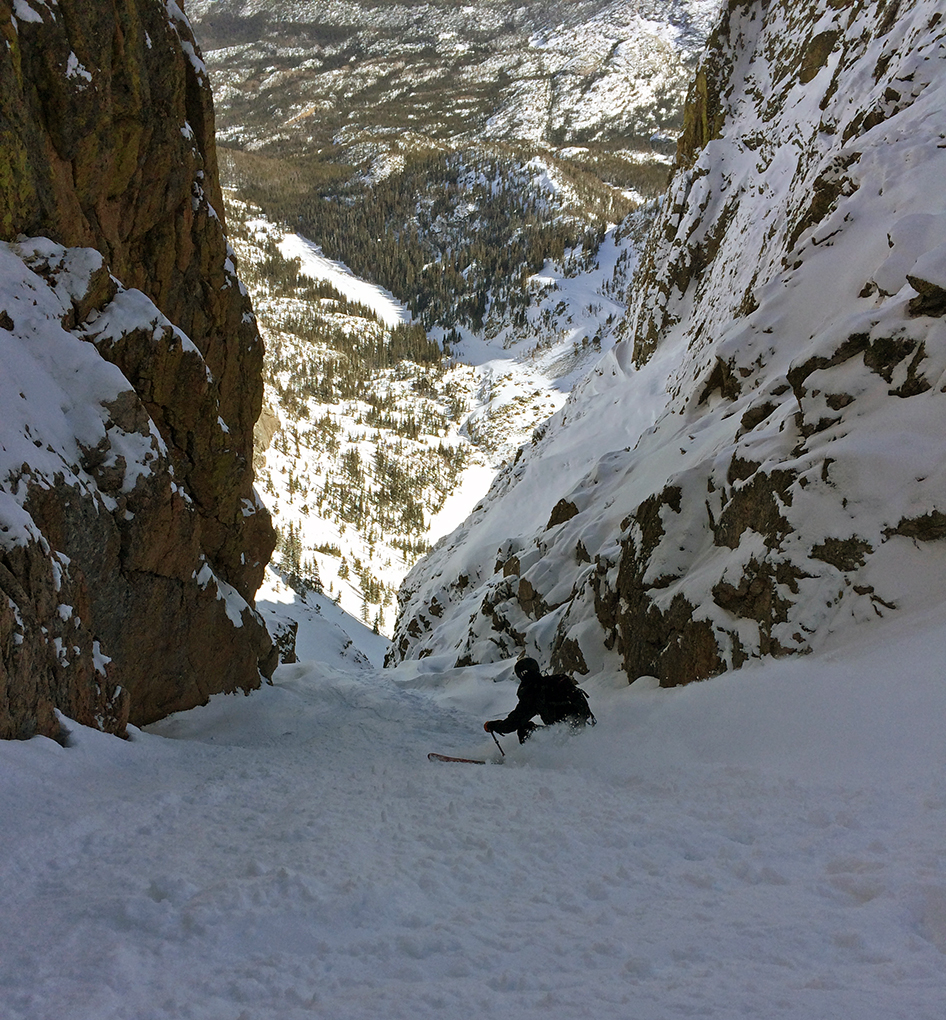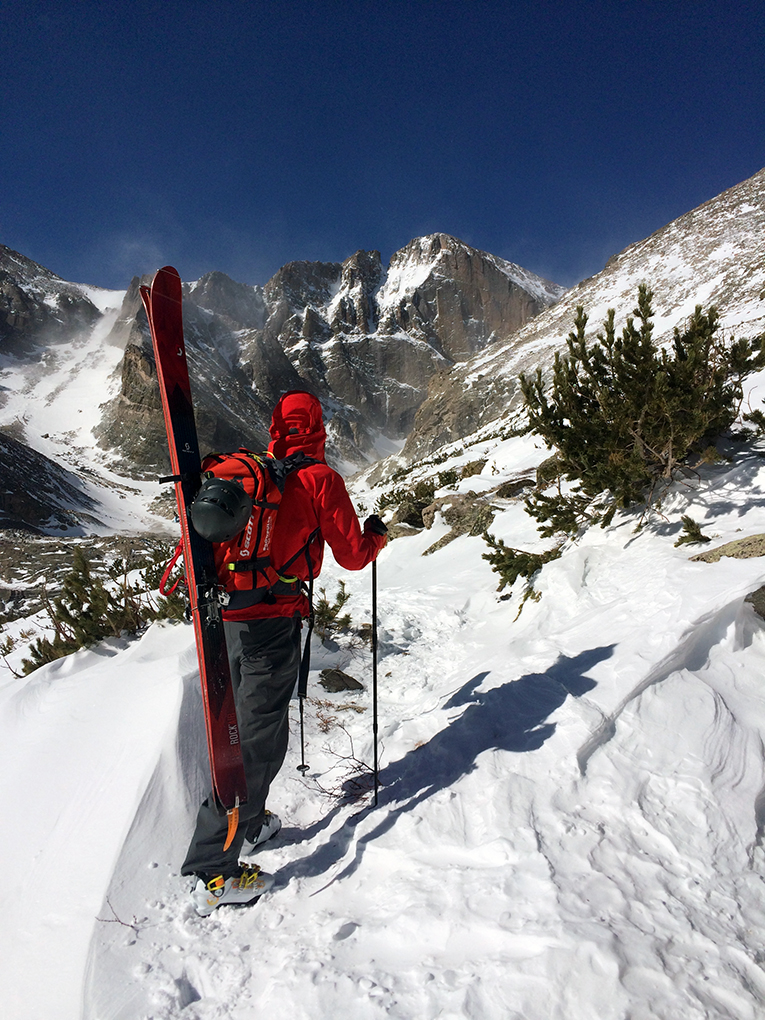
SCOTT Rock’Air, 183cm
Stated Dimensions: 137-105-127mm
Stated Sidecut Radius: 21 meters
Stated Weight: 3,420 grams per pair
Features:
- Pro Tip Rocker 375
- Paulowina wood core
- Full length carbon stringers
- SSCL (sandwich sidewall construction)
- Dual radius sidecut
- Easy skin attachment
MSRP: $600
Reviewer: 5’10”, 135 lbs.
Boots / Bindings: Scarpa Maestrale RS / Dynafit Radical ST
Test Locations: Rocky Mountain National Park & Front Range backcountry, Colorado
Days Skied: 20
[Editor’s Note: Our review was conducted on the 14/15 Rock’Air, which was not changed for 15/16, except for the graphics.]
SCOTT bills the Rock’Air as their do-everything backcountry touring ski, and the Rock’Air doesn’t disappoint. It is lightweight and performs exactly as you’d expect it to, no surprises.
And for a ski like this, I think that’s a really good thing.
The Rock’Air has pretty conventional dimensions, subtle tip rocker, and almost flat tails. Its flex is moderate throughout. There is no wild design story here.
And for all of those reasons, this is exactly the sort of ski I want for backcountry touring.
I’ve skied the Rock’Air in everything from bottomless fluff (seriously bottomless—it was a top-3 day of my life) to bulletproof ice and everything in-between, and the Rock’Air has always just worked.
Camber / Rocker Profile
The Rock’Air has a modest amount of tip rocker, and the tips have a pretty traditional look and feel.
Its tails are almost flat. The last 2” or so turn up slightly, but there is essentially no tail rocker.
The tails are flat enough to use as an anchor if necessary, though they are not quite as secure as a perfectly flat tail would be. I personally only use my skis as a snow anchor as a last resort (rock and ice are just better), but it’s nice to know that I can use the Rock’Air in a pinch.
The Rock’Airs have a pretty mellow camber profile, 1-2 millimeters underfoot.
What this relatively traditional rocker / camber profile forfeits in deep snow playfulness, it gains back in practicality. Skinning surface area is large. I have been able to leave the skins on much longer than partners using rockered touring skis (like the BD Verdict) simply because I am working with a bit more effective edge.
Flex Pattern
Moderate. The Rock’Air has a pretty even flex. It is stiffer underfoot, with shovels that are slightly softer than its tails. I would describe the overall flex of the Rock’Air as “medium.” The flex feels supportive (certainly for someone of my weight), but this is certainly not some stiff charger. It is forgiving, but it is not a noodle. Medium.

Powder
As I said above, I had one of the best days of my life on the Rock’Air: 35”+ of light, fresh snow over a stable, spring snowpack. Snorkel conditions.
The Rock’Air’s shovels don’t float in snow like this, not even close. However, the ski was a predictable submarine, and handled invisible compressions and floaty roll-overs well.
In less deep pow (10-20”), the Rock’Airs’ tips still don’t stay afloat all the time. But when I wanted the shovels up and planing, I just needed to get my weight back a bit and they would pop up. In cold, dry, Colorado champagne though, all but the widest skis will sink, and the Rock’Air is no exception.
The Rock’Air is not a surfy backcountry ski. But the upside is that even on a 6” pow day, you’ll be making fun, bouncy turns.
Unsurprisingly, in deep snow, I found myself occasionally wishing for a touch more width and length. However, I have no interest in compromising the Rock’Air’s hard snow performance, so I never found myself wishing too hard to alter the attributes of this ski.
Chop and Crud
This shouldn’t really need to be pointed out, but the Rock’Air is not a damp charger that will plough through chop and crud. Its low weight means that the tips are relatively easily deflected, and it takes some attentiveness to keep the skis on track in deep chop or crud.
The Rock’Airs don’t fold in chop — the flex pattern of the shovels is substantial enough to keep that from happening; they just get bounced around, since the ski is really light.
Chop and crud performance is definitely the Rock’Air’s weakness, but because I rarely ski chop and crud in the backcountry, I’m willing to deal with this. If you’re looking for better chop and crud performance and you’re willing to drag a heavier ski uphill, consider the Volkl V-Werks Katana.

Spring Corn
The Rock’Air is comfortable railing high speed turns in forgiving corn conditions. The ski is pretty torsionally stiff underfoot, so it’s responsive to hard edging — if mounted with a binding that can handle it, that is.
The Rock’Air has a really snappy and lively feel. The combination of flat tails and carbon stringers allow these skis to pop nicely from turn to turn.
At least for someone of my weight, I think SCOTT has the flex just about dialed here for corn skiing.
Ski Mountaineering / Icy Crap
When ski mountaineering, you often end up skiing some pretty bad snow, which I did on the Rock’Air. Refrozen bulletproof, with 1-2” of blower swirling around on top.
The best thing I can say about the Rock’Air is that I never stood on top of a crappy line and said to myself, “I wish I was on a different ski.” The Rock’Air’s girth, torsional rigidity, and effective edge have kept me confident in conditions and terrain where good edges are your best friend.
Furthermore, in technical terrain, regardless of the conditions, the Rock’Air again strikes a good middle ground. A lot of touring skis are really turn-y, and when a sidecut radius gets around 17 meters, I find I have to work harder in steep, tight terrain to keep the skis pointing where I want. The Rock’Air’s 21 meter radius still makes the ski easy enough to jump-turn down steep couloirs, but is long enough to provide some stability through bigger turns down an apron.
When ski mountaineering, you want to be the boss of your skis, and the Rock’Air does what it’s told.
Bottom Line
If you’re looking for a predictable, traditional-feeling ski with a medium side cut, medium flex, and a very light weight, I think you’ll be very happy with the SCOTT Rock’Air. It’s a tool, not some toy. It will get you where you need to go in the backcountry, and it will get you safely back down.
I am spending this season touring and mountaineering in the Swiss Alps, and I plan on using the Rock’Air most of the days I’m out — that’s high praise.
NEXT: ROCKER PROFILE PICS

Nice to see Blister reviewing more dedicated touring skis such as this and the Voile Charger BC. Keep up the good work.
Hey Sam- Put on some weight. You are making me look bad. I hope you will journal your experience in Switz this winter. I will be there in Europe Feb. 7-15. Looking at Corchevel, Val d’isere., etc. Looking for good snow. Best wishes. The alps are special. I know, I gained 15 pounds over there.
I hope to be including updates on time out here in my reviews throughout the winter. I have a few cool reviews lined up that I’m excited about. Corchevel and Val d’isere should be excellent! I’m based in Bern right now so I’ll be focused on south central Switzerland but those areas look sick!
With all this cheese and chocolate, I’d be surprised if I didn’t put on 15 pounds – uhhhh – 7 kilos I mean…
Cheers!
Hi Sam, Hope you got some nice trips in the Swiss Alps. Conditions have been quite good so far and the season isn’t over yet. Any updates on your Scott Rock’Air review?
Hey Ernst,
I have been getting some great skiing in out here. Glad the spring season is finally here! No big changes in my review. This is still my everyday touring ski. It’s predictable and reliable. I dig it!